Stressed hepatocyte sustains alcohol-associated hepatitis progression by producing leukocyte cell-derived chemotaxin 2
IF 23
1区 医学
Q1 GASTROENTEROLOGY & HEPATOLOGY
引用次数: 0
Abstract
Background Neutrophil infiltration and hepatocyte damage are indispensable hallmarks in alcohol-associated hepatitis (AH), yet the underlying crosstalk between neutrophils and hepatocytes and its role in AH pathogenesis remain unclear. Objective We investigate the regulatory role of leucocyte cell-derived chemotaxin 2 (LECT2) in hepatocyte–neutrophil interaction and its impact on AH progression. Design We used bulk and single-cell RNA sequencing to identify hepatocyte-secreted factors targeting neutrophils. We analysed serum and liver samples from AH patients and employed genetically modified mice alongside in vitro studies. Results RNA-sequencing analysis identified several neutrophil chemokines that are elevated in hepatocytes from AH patients, including LECT2 whose role in AH remains largely unknown. AH patients exhibited increased levels of LECT2 in hepatocytes, positively correlating with the severity of AH. Ethanol-fed mice also exhibited elevated liver LECT2, which was abolished by inhibiting endoplasmic reticulum stress. Functional studies revealed that ethanol-induced liver injury was ameliorated in Lect2 -deficient mice but was exacerbated in mice with hepatic overexpression of Lect2 . Furthermore, LECT2 exacerbated ethanol-induced liver injury by promoting reactive oxygen species (ROS) through its interaction with prohibitin 2 (PHB2), a neutrophil membrane protein. By directly binding to PHB2, LECT2 disrupts the stable structure of PHB1/PHB2 heterodimerisation, consequently leading to PHB2 degradation, ROS accumulation, neutrophil activation and neutrophil extracellular trap formation. Moreover, therapeutic intervention of LECT2 via Lect2 shRNA ameliorated ethanol-induced liver injury. Conclusion Our studies identified a novel vicious cycle between neutrophils and hepatocytes through the LECT2–PHB2 interaction, presenting a promising therapeutic intervention by targeting LECT2 to mitigate AH in patients. Data are available upon reasonable request. The data that support the findings of this study are available on request from the corresponding authors.求助全文
约1分钟内获得全文
求助全文
来源期刊

Gut
医学-胃肠肝病学
CiteScore
45.70
自引率
2.40%
发文量
284
审稿时长
1.5 months
期刊介绍:
Gut is a renowned international journal specializing in gastroenterology and hepatology, known for its high-quality clinical research covering the alimentary tract, liver, biliary tree, and pancreas. It offers authoritative and current coverage across all aspects of gastroenterology and hepatology, featuring articles on emerging disease mechanisms and innovative diagnostic and therapeutic approaches authored by leading experts.
As the flagship journal of BMJ's gastroenterology portfolio, Gut is accompanied by two companion journals: Frontline Gastroenterology, focusing on education and practice-oriented papers, and BMJ Open Gastroenterology for open access original research.
 求助内容:
求助内容: 应助结果提醒方式:
应助结果提醒方式:


